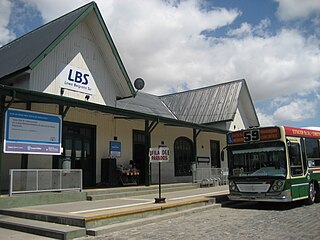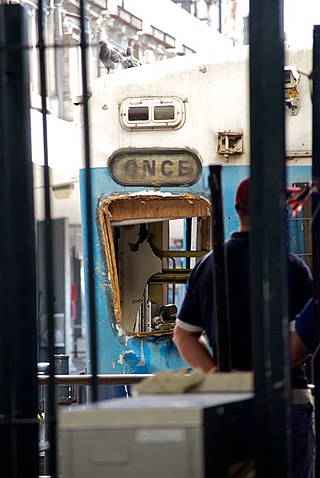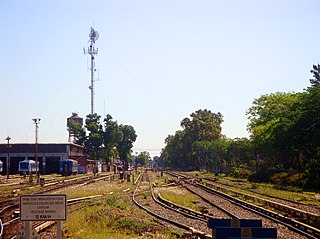
Retiro is a barrio or neighborhood in Buenos Aires, Argentina. Located in the northeast end of the city, Retiro is bordered on the south by the Puerto Madero and San Nicolás, and on the west by the Recoleta.

Buenos Aires is a former passenger railway station in the city of Buenos Aires, Argentina. The station was terminus of the Belgrano Sur line that runs trains along Greater Buenos Aires region.

Flores is a middle-class barrio or district in the center part of Buenos Aires city, Argentina. Flores was considered a rural area of the Province of Buenos Aires until 1888 when it was integrated into the city. Flores is the birthplace of Pope Francis.

Villa Soldati is a neighbourhood in Buenos Aires, Argentina, located in the South-West of the city. It has a population of approximately 41,000 people, 40% of which live in Barrio Soldati, a public housing development built between 1973 and 1979.

Villa Lugano is a barrio (neighbourhood) in Buenos Aires, Argentina, located in the south of the city. It has a population of approximately 114,000 people. It is delimited by Avenida Eva Perón, Avenida General Paz, Calle José Barros Pazos, Avenida Lisandro de la Torre, Avenida Coronel Roca and Avenida Escalada. To the south-east it limits with La Matanza Partido.
Sociedad Comercial del Plata is a diversified Argentine holding company, with interests primarily in the energy, rail transport, real estate, and tourism sectors.
Parque de la Costa is an amusement park located in Tigre, a northern suburb of Buenos Aires, Argentina.

The Benavídez rail disaster, which occurred on February 1, 1970, is the worst-ever rail disaster in Argentina and South America, leaving 236 dead and more than 500 injured.
Parque Indoamericano is a park in the Villa Soldati and Villa Lugano neighbourhoods of Buenos Aires, Argentina. It covers approximately 130 hectares, and is thus the second-biggest park in the city.

Autovía 2 Juan Manuel Fangio is an Argentine dual carriageway, which runs from Buenos Aires to Mar del Plata. The road was a National Route until 1990 when it was transferred to the Government of Buenos Aires Province. The Autovía 2 extends from the junction of Provincial Routes 1 and 36 and National Route A004, just on the traffic circle "Juan María Gutiérrez", which is the limit of Berazategui and Florencio Varela districts.

The 2012 Buenos Aires rail disaster, also known as the Once Tragedy, occurred on 22 February 2012, when a train crashed at Once Station in the Balvanera neighbourhood of Buenos Aires, Argentina.

The 2011 Flores rail crash occurred at 06.23 ART on 13 September 2011 when a bus on a level crossing at Flores railway station, in the Flores barrio of Buenos Aires, Argentina, was hit by a train on the Sarmiento Line, heading for Moreno. The accident caused that same train to collide into another one as it derailed.

The 2013 Castelar rail disaster occurred on 13 June 2013 at about 07:30 local time, in the Castelar neighborhood of Morón Partido in Greater Buenos Aires area, about 30km west of the city of Buenos Aires, Argentina.

The Buenos Aires train crash occurred on October 19, 2013 when a passenger train failed to stop at a terminal station in Buenos Aires, Argentina, injuring 105 people. As of October 2013, the cause of the accident was sleeping at the controls.

Provincial Route 63 is a 29-kilometre-long (18 mi) Argentine road in the East of Buenos Aires Province. The road extends from Dolores, Buenos Aires to the "Esquina de Crotto", a paraje in Tordillo Partido.
Guillermo Laza stadium is an association football stadium located in the Villa Soldati neighbourhood in Buenos Aires, it has a capacity is 3,000 in its three stands, one of which is for seating. Its facilities include press cabins, training field and indoor stadium.













